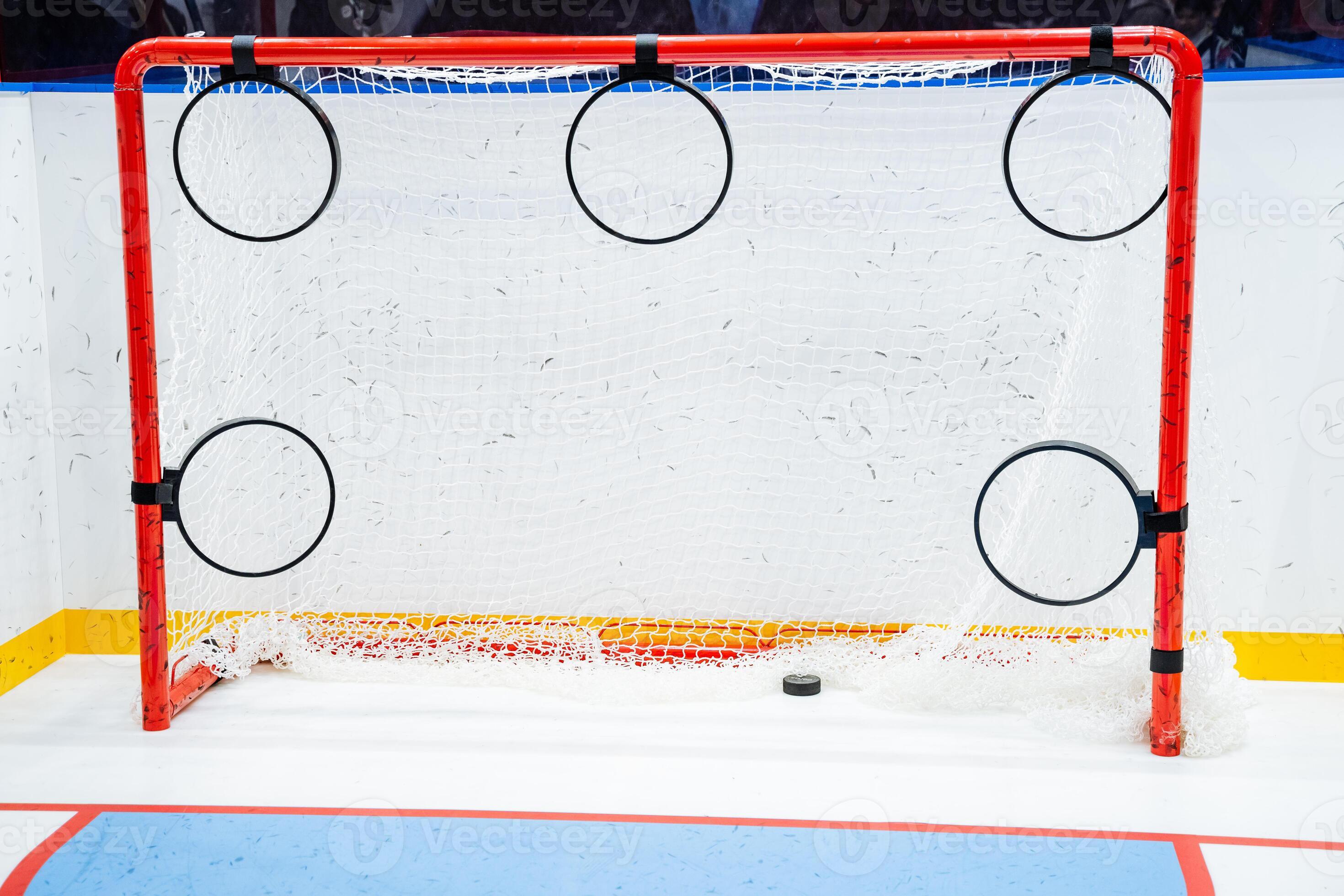Hockey is an exciting sport loved by many. The goal is a crucial part of the game.
Understanding hockey goal components is essential. These parts work together to ensure fair play and safety. This blog post explores the different elements that make up a hockey goal. From the netting to the frame, each part plays a vital role.
By knowing these components, fans and players can appreciate the game even more. Let’s dive into the world of hockey goal components and see how they contribute to this thrilling sport.
Goal Frame
The hockey goal frame provides sturdy support for the net. Made of durable materials, it ensures stability during intense matches. Easy to assemble and disassemble for quick setup and storage.
The goal frame is a crucial component of a hockey goal. It provides the structure and stability needed to withstand the force of the game. Understanding the materials and durability factors can help you choose the best goal frame for your needs.Materials Used
Hockey goal frames are typically made from steel or aluminum. Steel frames are sturdy and can handle intense impacts from pucks and players. Aluminum frames, on the other hand, are lighter and more portable, making them ideal for practice goals. Some frames also feature a powder-coated finish. This coating helps prevent rust and adds an extra layer of durability. When selecting a frame, consider where you will be using it most—indoors or outdoors—as this can impact your material choice.Durability Factors
The thickness of the material is a key factor in a frame’s durability. Thicker steel or aluminum will last longer and hold up better under pressure. Look for frames with reinforced corners, as these areas often take the brunt of collisions. Consider the welding quality. Poorly welded joints can break or bend, compromising the frame’s integrity. High-quality welds ensure that the frame remains solid and secure, even after repeated use. Lastly, think about the goal’s environment. If you leave your goal outside, it needs to withstand weather conditions. Opt for frames with UV protection and rust-resistant coatings for outdoor use. Have you ever had a goal frame that didn’t last a season? What factors do you think contributed to its failure? Share your thoughts in the comments below!
Credit: dazepuzzle.com
Netting
Netting is a crucial part of a hockey goal, keeping the puck inside the goal. It ensures clear scoring.
Hockey is a fast-paced and thrilling sport. A key component that ensures the game runs smoothly is the netting of the goal. Whether you’re a player, coach, or fan, understanding the importance of goal netting can enhance your appreciation of the game.Types Of Netting
Different types of netting are designed to meet various needs. Nylon netting is popular because it is durable and resistant to wear and tear. It’s great for outdoor rinks where it can withstand harsh weather. Polyethylene netting is another common type. It’s known for its UV resistance, making it ideal for sunny locations. However, it might not be as durable as nylon in rough conditions. Finally, polypropylene netting offers a balance of durability and flexibility. It’s often used in professional settings. Each type has its strengths, so choose the one that fits your needs best.Maintenance Tips
Maintaining your hockey goal netting is crucial. Regular checks can prevent small issues from becoming big problems. Look for any tears or frayed edges and repair them immediately. Keep the netting clean. Dirt and debris can weaken the fibers over time. Use a mild detergent and water to clean the netting every few weeks. Store your netting properly when not in use. Avoid leaving it out in harsh weather conditions. Roll it up and keep it in a dry, cool place to extend its life. Have you ever had a game interrupted by a broken net? It’s frustrating and avoidable with proper care. Take these simple steps to ensure your netting is always game-ready.Goal Padding
When it comes to hockey goals, goal padding is an essential component that ensures player safety and enhances the game experience. Proper padding can make a significant difference in the performance and durability of the goal. Let’s delve into its purpose and how to choose the right padding for your needs.
Purpose Of Padding
Goal padding serves multiple functions in a hockey game. Firstly, it protects the goal structure from high-impact shots. This is crucial because hockey pucks can travel at incredible speeds, and without proper padding, the goal could sustain damage quickly.
Secondly, padding enhances player safety. Imagine a player crashing into an unpadded goalpost. The risk of injury would be significantly higher. Adequate padding absorbs impact and minimizes injury risks, making the game safer for everyone involved.
Finally, padding helps maintain the goal’s position during play. Without it, a goal might shift or move, disrupting the game. Properly padded goals stay in place, ensuring that the game continues smoothly and fairly.
Choosing The Right Padding
Selecting the right padding can be a game-changer. You need to consider the level of play. Professional settings demand higher-quality, durable padding that can withstand intense play. On the other hand, for casual or youth games, lighter, more affordable padding might suffice.
Consider the material. Foam padding is popular due to its excellent shock-absorbing properties. However, not all foam is created equal. High-density foam offers more protection and lasts longer, though it can be pricier. Weigh the pros and cons based on your specific needs and budget.
Another factor is the ease of installation. Some padding requires more effort to install securely. If you’re setting up a goal in a multi-use area, you might prefer padding that can be easily attached and removed. Read reviews and get recommendations to find user-friendly options.
Have you ever had a goal with inadequate padding? The constant repositioning and potential damage can be frustrating. By investing in the right padding, you save time and ensure a more enjoyable playing experience. What padding options have you found effective? Share your thoughts and experiences in the comments below!
Anchoring Systems
Anchoring systems are crucial for hockey goals. They keep the goal secure during play. Proper anchoring prevents accidents and ensures safety. Understanding the different types of anchoring systems is essential. This guide will help you choose and install the right system.
Types Of Anchoring
There are several types of anchoring systems for hockey goals. Each type has its own advantages.
In-ground anchors: These are fixed into the ground. They offer the best stability. Suitable for permanent setups.
Sandbags or weights: These are portable. Easy to move and adjust. Ideal for temporary setups.
Stake anchors: These are driven into the ground. Provide good stability. Often used on grass fields.
Installation Guide
Installing an anchoring system is straightforward. Follow these steps for a secure setup:
In-ground anchors: Mark the spot where the anchors will go. Dig holes to the required depth. Insert the anchors and fill the holes. Compact the soil firmly. Attach the goal to the anchors.
Sandbags or weights: Place the sandbags at the base of the goal. Ensure they are evenly distributed. Check for stability. Adjust as needed.
Stake anchors: Position the goal where you want it. Drive the stakes into the ground. Attach the goal to the stakes. Ensure the stakes are secure.
Regularly check all anchoring systems. Ensure they remain secure and safe. Replace any worn or damaged parts immediately.
Replacement Parts
Maintaining a hockey goal is crucial for any player or team. Over time, parts of the goal can wear out or get damaged. Replacement parts are essential to keep the goal in good condition. Regularly checking and replacing these parts ensures the goal remains safe and functional.
Common Replacement Parts
Several parts of a hockey goal may need replacement. The net is the most common part that wears out. Frequent impact from pucks can cause holes and tears. Goal posts and frames can also suffer damage over time. These parts may bend or break from strong hits. Another vital part is the backstop padding. This padding protects players and absorbs impact. It can wear down and lose effectiveness. Lastly, the net clips and ties can become loose or break. They secure the net to the frame and are crucial for stability.
When To Replace
Knowing when to replace parts is important. Inspect the net regularly for holes and tears. Replace it if damage is visible. Check the goal posts and frame for bends or breaks. Replace any damaged parts to maintain structural integrity. Examine the backstop padding. If it feels thin or damaged, replace it to ensure safety. Lastly, check the net clips and ties. Replace them if they are loose or broken to keep the net secure.

Credit: www.vecteezy.com
Safety Features
Hockey goal components include essential safety features like padded frames and secure netting. These elements prevent injuries during intense games.
### Safety Features Hockey is an exhilarating sport, but it comes with its risks. Ensuring the safety of players, especially goalies, is paramount. Let’s dive into the essential safety features of hockey goals that help protect everyone on the ice.Safety Standards
Hockey goals need to meet strict safety standards. These standards ensure that the equipment is reliable and safe for all players. Look for goals that comply with regulations set by major hockey organizations. This guarantees that the goals are built to withstand intense gameplay. Using certified goals can prevent injuries and give players peace of mind. Knowing the equipment is safe allows players to focus on the game.Incorporating Safety
Safety is a key factor when adding hockey goals to your rink. Modern goals come with features designed to minimize risk. Padding: Many goals now include padding to cushion impacts. This padding can reduce injuries when players crash into the goal. Anchoring Systems: Secure anchoring systems keep the goal in place during play. This prevents the goal from tipping over or shifting unexpectedly. Rounded Edges: Rounded edges on the frame reduce the chance of cuts and bruises. Sharp corners are a thing of the past in safer designs. Netting: High-quality netting is crucial for player safety. Durable, tear-resistant nets ensure that the puck stays contained, reducing the risk of injuries.Have you ever experienced or witnessed a near-miss injury on the ice? Share your thoughts and tips on how to enhance safety in hockey. Your insights could help make the game safer for everyone.
Buying Guide
When buying a hockey goal, you need to consider various factors to make a smart purchase. A well-chosen goal can significantly enhance your practice sessions, whether you’re a beginner or a seasoned player. Let’s dive into the essential aspects you should keep in mind.
Top Brands
Choosing a reliable brand can make all the difference in durability and performance. Look for brands that are well-known in the hockey community. For example, Bauer and Franklin Sports offer high-quality goals that withstand rigorous use.
Another excellent brand is EZGoal, which is famous for its foldable design and sturdy construction. Consider checking out reviews and asking fellow players about their experiences with different brands. Your choice could impact the longevity of your goal.
Budget Considerations
Hockey goals come in various price ranges. You don’t need to break the bank to get a decent one. However, investing a bit more can get you a goal that lasts longer and requires less maintenance.
If you’re on a tight budget, look for deals online or consider purchasing a used goal. Just make sure to inspect it thoroughly for any damage. Spending wisely now can save you money in the long run.
Do you want to prioritize cost or quality? Balancing these factors is crucial. Remember, a high-quality goal can enhance your practice and improve your skills.

Credit: www.nhl.com
Frequently Asked Questions
What Is Required For A Goal In Hockey?
A goal in hockey requires the puck to completely cross the goal line between the goalposts and under the crossbar.
What Are Hockey Goals Made Of?
Hockey goals are typically made of steel or aluminum frames. The nets are made of durable nylon.
What Are The Posts Of A Hockey Goal?
The posts of a hockey goal are the vertical bars on each side. They are connected by a horizontal crossbar.
What Is An Ice Hockey Goal Called?
An ice hockey goal is called a “goal”. It is the term used when the puck crosses the goal line.
Conclusion
Understanding hockey goal components helps improve gameplay and safety. Each part plays a crucial role. Proper maintenance ensures durability and performance. Invest in quality materials for long-lasting equipment. Always check for wear and tear. Regular inspections prevent accidents and enhance game quality.
Knowledge of these components builds better skills. Equip yourself wisely for a great hockey experience. Stay informed, stay safe, and enjoy the sport.



